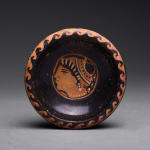Apulian Red-Figure Dish, 400 BCE - 300 BCE
Terracotta
2.9 x 9.8 cm
1 1/8 x 3 7/8 in
1 1/8 x 3 7/8 in
CK.0012
Further images
In an overview of Ancient Greek pottery, perhaps no single style is as charming as the works originating from the Italian province of Apulia. The Greek colonies of southern Italy...
In an overview of Ancient Greek pottery, perhaps no single style is as charming as the works originating from the Italian province of Apulia. The Greek colonies of southern Italy (known in antiquity as Magna Grecia) were marked by their initial allegiance to the ceramic styles of the Attic mainland. However, over the years, native traditions and innovations heavily influenced the works of Magna Grecian potters. Unorthodox forms and painting-styles were seamlessly merged with the standard Greek style, creating distinctive works of art unique to the Hellenistic world.
This beautiful, shallow, ring-base dish reveals the extraordinary artistic sensibilities of the western Greeks, reflecting their successful assimilation of the traditional Greek artistic styles with the local, non-Greek artistic tastes and techniques. The portrait of a woman as a form of ceramic decoration was quite popular in this region of Italy during the 4th century B.C., and this painted dish is a fine example of such works. Here, we see a lovely rendition of a woman’s head, the high quality of drawing readily appreciated as we observe the rendering of her subtle facial features and adornments. In her hair, she wears a saccos, the characteristic cloth head cover worn during this era, and a stephane, or wreath. An earring adorns her ear while a dotted necklace graces her neck. A reserve band of red handsomely frames the overall scene, and the rim of the dish is further adorned with a band of waves.
This beautiful, shallow, ring-base dish reveals the extraordinary artistic sensibilities of the western Greeks, reflecting their successful assimilation of the traditional Greek artistic styles with the local, non-Greek artistic tastes and techniques. The portrait of a woman as a form of ceramic decoration was quite popular in this region of Italy during the 4th century B.C., and this painted dish is a fine example of such works. Here, we see a lovely rendition of a woman’s head, the high quality of drawing readily appreciated as we observe the rendering of her subtle facial features and adornments. In her hair, she wears a saccos, the characteristic cloth head cover worn during this era, and a stephane, or wreath. An earring adorns her ear while a dotted necklace graces her neck. A reserve band of red handsomely frames the overall scene, and the rim of the dish is further adorned with a band of waves.





